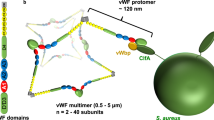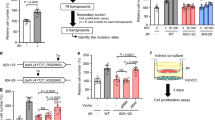Abstract
Staphylococcus aureus infection is one of the leading causes of morbidity in hospitalized patients in the United States, an effect compounded by increasing antibiotic resistance. The secreted agent hemolysin alpha toxin (Hla) requires the receptor A Disintegrin And Metalloproteinase domain-containing protein 10 (ADAM10) to mediate its toxic effects. We hypothesized that these effects are in part regulated by Notch signaling, for which ADAM10 activation is essential. Notch proteins function in developmental and pathological angiogenesis via the modulation of key pathways in endothelial and perivascular cells. Thus, we hypothesized that Hla would activate Notch in vascular cells. Human umbilical vein endothelial cells were treated with recombinant Hla (rHla), Hla-H35L (genetically inactivated Hla), or Hank’s solution (HBSS), and probed by different methods. Luciferase assays showed that Hla (0.01 µg/mL) increased Notch activation by 1.75 ± 0.5-fold as compared to HBSS controls (p < 0.05), whereas Hla-H35L had no effect. Immunocytochemistry and Western blotting confirmed these findings and revealed that ADAM10 and γ-secretase are required for Notch activation after inhibitor and siRNA assays. Retinal EC in mice engineered to express yellow fluorescent protein (YFP) upon Notch activation demonstrated significantly greater YFP intensity after Hla injection than controls. Aortic rings from Notch reporter mice embedded in matrix and incubated with rHla or Hla-H35L demonstrate increased Notch activation occurs at tip cells during sprouting. These mice also had higher skin YFP intensity and area of expression after subcutaneous inoculation of S. aureus expressing Hla than a strain lacking Hla in both EC and pericytes assessed by microscopy. Human liver displayed strikingly higher Notch expression in EC and pericytes during S. aureus infection by immunohistochemistry than tissues from uninfected patients. In sum, our results demonstrate that the S. aureus toxin Hla can potently activate Notch in vascular cells, an effect which may contribute to the pathobiology of infection with this microorganism.







Similar content being viewed by others
Abbreviations
- Hla:
-
Alpha toxin
- EC:
-
Endothelial cell
- HUVEC:
-
Human umbilical endothelial cell
- EDTA:
-
Ethylenediaminetetraacetic acid
- ADAM10:
-
A disintegrin and metalloproteinase domain-containing protein-10
References
Le J et al (2017) Epidemiology and hospital readmission associated with complications of Staphylococcus aureus bacteremia in pediatrics over a 25-year period. Epidemiol Infect 145(12):2631–2639
Shenoy ES et al (2016) The impact of methicillin-resistant Staphylococcus aureus (MRSA) and vancomycin-resistant enterococcus (VRE) flags on hospital operations. Infect Control Hosp Epidemiol 37(7):782–790
Inoshima N, Wang Y, Bubeck J, Wardenburg (2012) Genetic requirement for ADAM10 in severe Staphylococcus aureus skin infection. J Invest Dermatol 132(5):1513–1516
Inoshima I et al (2011) A Staphylococcus aureus pore-forming toxin subverts the activity of ADAM10 to cause lethal infection in mice. Nat Med 17(10):1310–1314
Wilke GA, Bubeck J, Wardenburg (2010) Role of a disintegrin and metalloprotease 10 in Staphylococcus aureus alpha-hemolysin-mediated cellular injury. Proc Natl Acad Sci USA 107(30):13473–13478
Powers ME et al (2012) ADAM10 mediates vascular injury induced by Staphylococcus aureus alpha-hemolysin. J Infect Dis 206(3):352–356
Lozano C et al (2011) Staphylococcus aureus nasal carriage, virulence traits, antibiotic resistance mechanisms, and genetic lineages in healthy humans in Spain, with detection of CC398 and CC97 strains. Int J Med Microbiol 301(6):500–505
van Tetering G et al (2009) Metalloprotease ADAM10 is required for Notch1 site 2 cleavage. J Biol Chem 284(45):31018–31027
Rand MD et al (2000) Calcium depletion dissociates and activates heterodimeric notch receptors. Mol Cell Biol 20(5):1825–1835
Uyttendaele H et al (1996) Notch4/int-3, a mammary proto-oncogene, is an endothelial cell-specific mammalian Notch gene. Development 122(7):2251–2259
Al Haj Zen A, Madeddu P (2009) Notch signalling in ischaemia-induced angiogenesis. Biochem Soc Trans 37(Pt 6):1221–1227
Peschon JJ et al (1998) An essential role for ectodomain shedding in mammalian development. Science 282(5392):1281–1284
Krebs LT et al (2000) Notch signaling is essential for vascular morphogenesis in mice. Genes Dev 14(11):1343–1352
Swiatek PJ et al (1994) Notch1 is essential for postimplantation development in mice. Genes Dev 8(6):707–719
Hartmann D et al (2002) The disintegrin/metalloprotease ADAM 10 is essential for Notch signalling but not for alpha-secretase activity in fibroblasts. Hum Mol Genet 11(21):2615–2624
VanDussen KL et al (2012) Notch signaling modulates proliferation and differentiation of intestinal crypt base columnar stem cells. Development 139(3):488–497
Wu Y et al (2010) Therapeutic antibody targeting of individual Notch receptors. Nature 464(7291):1052–1057
Carulli AJ et al (2015) Notch receptor regulation of intestinal stem cell homeostasis and crypt regeneration. Dev Biol 402(1):98–108
Ridgway J et al (2006) Inhibition of Dll4 signalling inhibits tumour growth by deregulating angiogenesis. Nature 444(7122):1083–1087
Noguera-Troise I et al (2006) Blockade of Dll4 inhibits tumour growth by promoting non-productive angiogenesis. Nature 444(7122):1032–1037
Hellstrom M et al (2007) Dll4 signalling through Notch1 regulates formation of tip cells during angiogenesis. Nature 445(7129):776–780
Chigurupati S et al (2007) Involvement of notch signaling in wound healing. PLoS ONE 2(11):e1167
Thurston G, Kitajewski J (2008) VEGF and Delta-Notch: interacting signalling pathways in tumour angiogenesis. Br J Cancer 99(8):1204–1209
Kangsamaksin T et al (2015) NOTCH decoys that selectively block DLL/NOTCH or JAG/NOTCH disrupt angiogenesis by unique mechanisms to inhibit tumor growth. Cancer Discov 5(2):182–197
Nowotschin S et al (2013) A bright single-cell resolution live imaging reporter of Notch signaling in the mouse. BMC Dev Biol 13:15
Baker M et al (2011) Use of the mouse aortic ring assay to study angiogenesis. Nat Protoc 7(1):89–104
Becker RE et al (2014) Tissue-specific patterning of host innate immune responses by Staphylococcus aureus alpha-toxin. J Innate Immun 6(5):619–631
Banerjee D et al (2015) Notch suppresses angiogenesis and progression of hepatic metastases. Cancer Res 75(8):1592–1602
Murtomaki A et al (2014) Notch signaling functions in lymphatic valve formation. Development 141(12):2446–2451
Gupta-Rossi N et al (2001) Functional interaction between SEL-10, an F-box protein, and the nuclear form of activated Notch1 receptor. J Biol Chem 276(37):34371–34378
Stahl A et al (2010) The mouse retina as an angiogenesis model. Invest Ophthalmol Vis Sci 51(6):2813–2826
Acknowledgements
We would like to thank Jan Kitajewski, Carrie Shawber, Henar Cuervo, and Darrell Yamashiro; The University of Chicago Imaging Core; The University of Chicago Human Tissue Resource Center; The University of Chicago Flow Cytometry Facility; Cancer Center Support Grant (P30CA014599). Funding for this project was provided by the Pediatric Cancer Foundation and The University of Chicago. This work was supported by NIH award AI097434 to J.B.W. G.R.S. has received support through NIH award 5 T32 GM7197 and the Genetics and Regulation Training Program at the University of Chicago.
Author information
Authors and Affiliations
Contributions
Conception and design: SLH, JJK, JB-W. Development of methodology: SLH, MN, GS, BL, RK. Acquisition of data: SLH, MN, GS, LW, BL, NB, AMD, JE, HB, RK, SS. Analysis and interpretation of data: SLH, MN, LW, BL, GS, NB, AMD, JE, JJK, RK, SS. Writing, review, and/or revision of the manuscript: SLH, JJK, JB-W. Administrative, technical, or material support: SLH, MN, LW, BL, NB, AMD, JE, RK, SS.
Corresponding author
Ethics declarations
Ethical approval
All studies involving animals were in accordance with the ethical standards and approved by the IACUC at the University of Chicago. All procedures performed in studies involving human participants were in accordance with the ethical standards of the University of Chicago IRB and/or national research committee and with the 1964 Helsinki declaration and its later amendments or comparable ethical standards.
Electronic supplementary material
Below is the link to the electronic supplementary material.
Supplementary Fig. 1
Quantitative PCR showing HUVEC transiently transfected with ADAM10 siRNA significantly reduced their ADAM10 expression 48 hours after transfection relative to Untreated, Non-targeting, and GAPDH siRNA pool transfected controls. p value represents t test. Graphs represent mean and standard deviation. (EPS 501 KB)
Supplementary Fig. 2
Hla’s HUVEC stimulation leads to nuclear localization of cleaved Notch1. 100× magnification of Hla stimulated cells, detailing nuclear localization of cN1 in HUVEC. cN1 levels are higher than DMSO, but lower than EDTA. The ADAM10 inhibitor GI254023X abrogates Hla/s activation of Notch. (EPS 3890 KB)
Supplementary Fig. 3
S. aureus infection activates Notch in liver perivascular cells. A) Liver sections from a patient with culture-positive S. aureus infection (right panels) had increased Notch expression (red) in EC (green, white arrows), compared to a non-infected control (left panels). B) Notch reporter mice with subcutaneous infection of S. aureus expressing Hla (right panel, WT Hla) resulted in Notch activation of α-SMA cells 16 days after infection, but a strain lacking Hla (left panel, ΔHla) does not. (EPS 4185 KB)
Rights and permissions
About this article
Cite this article
Hernandez, S.L., Nelson, M., Sampedro, G.R. et al. Staphylococcus aureus alpha toxin activates Notch in vascular cells. Angiogenesis 22, 197–209 (2019). https://doi.org/10.1007/s10456-018-9650-5
Received:
Accepted:
Published:
Issue Date:
DOI: https://doi.org/10.1007/s10456-018-9650-5




